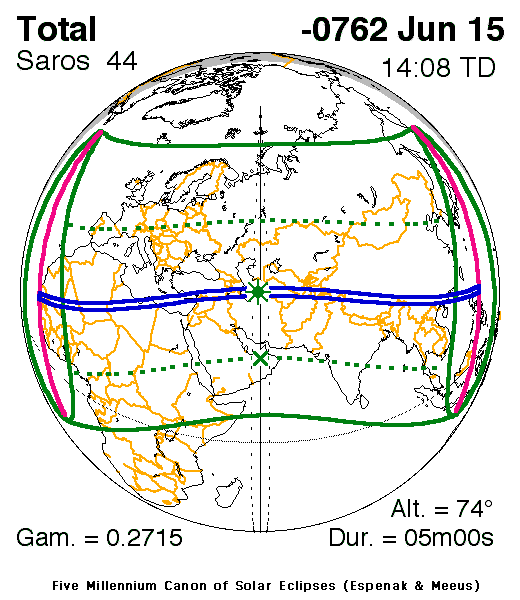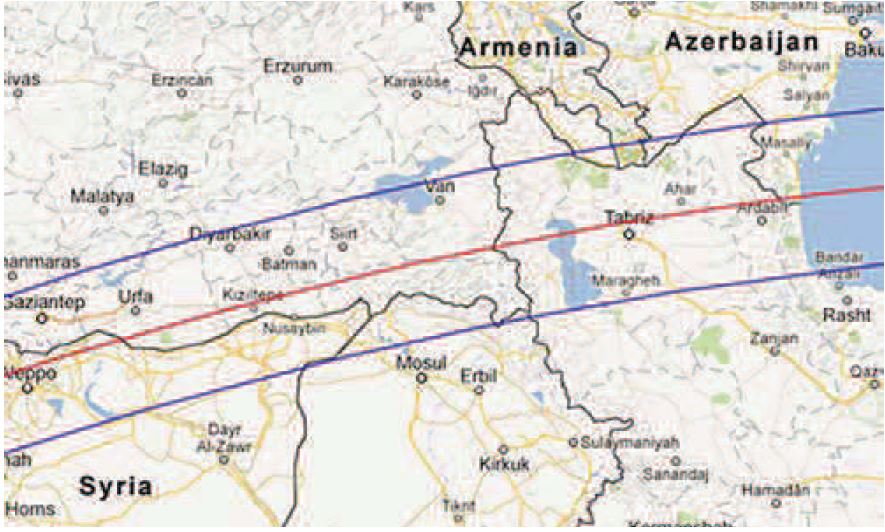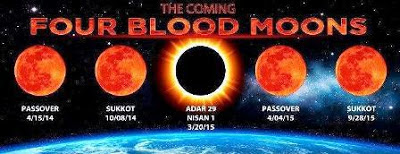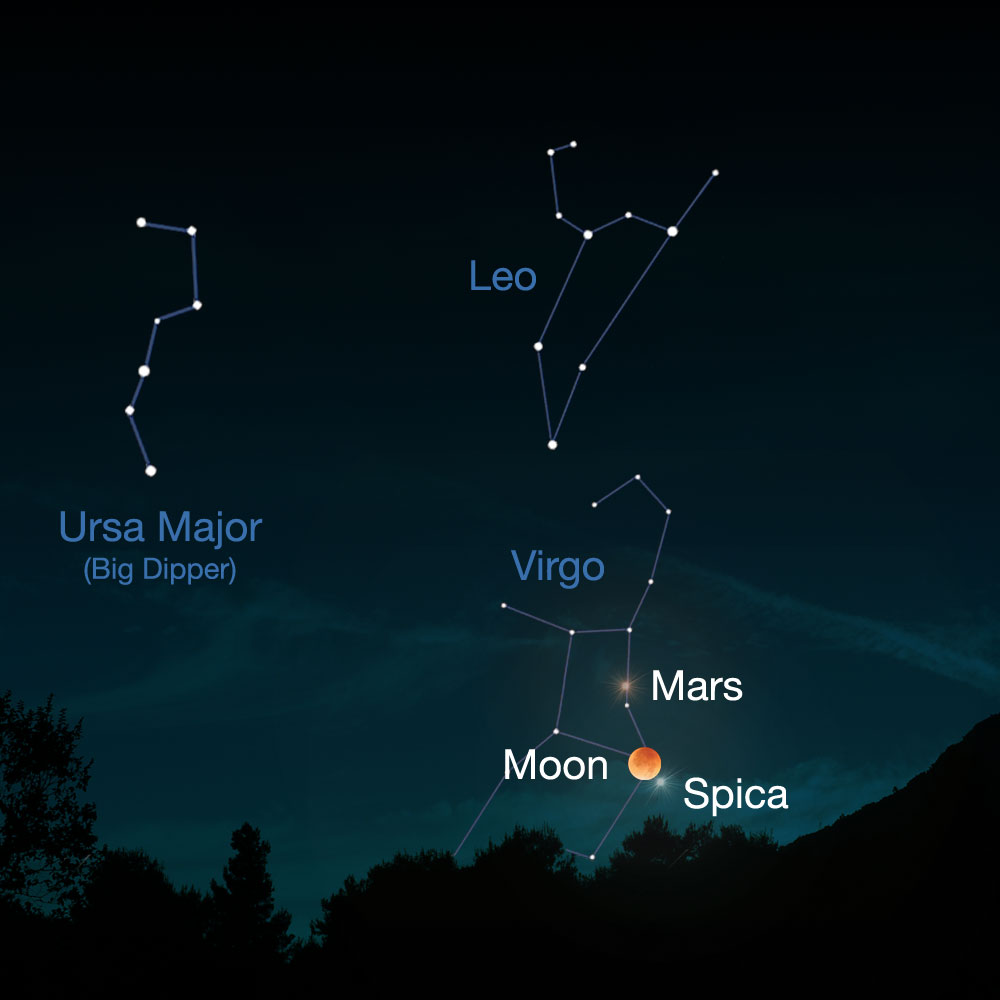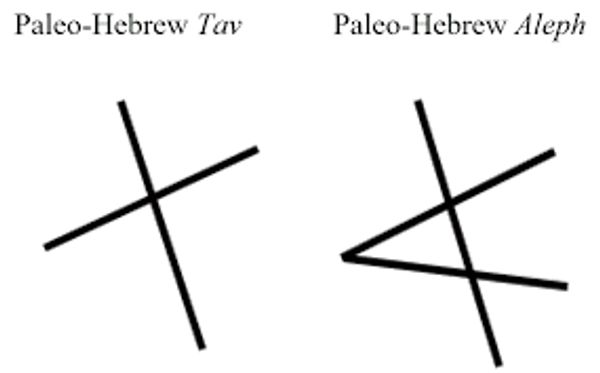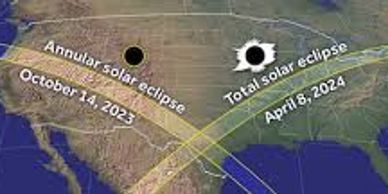
The Vast Void in the Great Pyramid and its Star Shafts.
Happy Pi Day everybody! For Pi Day in 2024 our focus is the recent discovery of a Void in the design of the Great Pyramid. This nebulous void in Egypt’s Great Pyramid of Giza has been unveiled thanks to strange subatomic particles called muons.
It was discovered in 2017, one year after the detection of a smaller void that turned out to be the recently-announced hidden passage. The mysterious cavity is the first major structure discovered inside the roughly 4,500-year-old Great Pyramid since the 19th century. The mission used cutting-edge technology in an attempt to settle how the pyramids were built and how they have remained to stay standing for so long, questions that remain unanswered after eight years of scans.
Researchers probed the Great Pyramid’s interior with devices that sense muons — by-products of spacefaring subatomic particles called cosmic rays striking atoms in the atmosphere. Muons continuously rain on Earth at nearly the speed of light. But while these subatomic particles easily streak through open air, rock can absorb or deflect them. By placing detectors near the base and areas deep inside of the Great Pyramid, and measuring the number of muons that reach the detectors from various directions, scientists could spot empty spaces inside the ancient edifice.
Figure. 1. The Great Pyramid’s Void with its passages and star shafts. #1
 PEERING INTO THE PYRAMID Using muon detectors installed inside and outside the pyramid (positions indicated with asterisks), researchers uncovered a mysterious void above the Grand Gallery. No one knows what the cavity is for, or even whether it consists of one or multiple chambers. SCANPYRAMIDS MISSION
PEERING INTO THE PYRAMID Using muon detectors installed inside and outside the pyramid (positions indicated with asterisks), researchers uncovered a mysterious void above the Grand Gallery. No one knows what the cavity is for, or even whether it consists of one or multiple chambers. SCANPYRAMIDS MISSION
Upon developing these films, the researchers saw a surprising excess of muons coming through a region above the Grand Gallery, a sloping corridor that runs north-south through the center of the pyramid. The cavity appears to be at least 30 meters across — about the size of the Grand Gallery itself. “Our first reaction was a lot of excitement,” says coauthor Mehdi Tayoubi, cofounder of Paris’ Heritage Innovation Preservation Institute.
The open space may comprise one or more rooms or corridors, but the particle-detector images reveal only the rough size of the void, not the details of its design. Eventually, though, this detail of the Great Pyramid’s architecture could offer new insights into one of the world’s largest, oldest and most famous monuments, the only one of the ancient Seven Wonders of the World that’s still standing. Since its discovery, the Big Void has been left unstudied because of its inaccessible location in the center of the Pyramid. Its function remains a mystery to those who have studied it.
Figure 2. Map of the Pyramid’s internal Chambers and shafts. #2
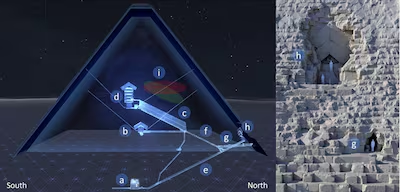
a. Subterranean chamber, b. Queen’s chamber, c. Grand Gallery, d. King’s chamber, e. Descending corridor, f. Ascending corridor, g. Al-Ma’mun corridor, h. north face Chevron area, i ScanPyramids Big Void with horizontal hypothesis (red hatching) and inclined hypothesis (green hatching) as published in November 20176. All these images were obtained from a 3D model using dedicated laser surveys and photogrammetry data. This diagram shows the different parts that scientists have discovered at the Great Pyramid of Giza through multiple scans. The letter ‘i‘ marks the position of the ‘Big Void,‘ an empty space in the center of the Pyramid that has baffled scientists for some time. The Great Pyramid structure was recently scanned by a mission from international imaging specialists, the findings were published in the prominent Science journal Nature. Photo credits: Nature. #3
“Whether it is a chamber, or a construction anomaly, or something else is not possible to say at this time. But the view of Peter Der Manuelian, a professor of Egyptology at Harvard University is the “void’s size alone makes it worthy of further investigation.”
The “Big Void“, the name given to it by the scientists, is encased in rock, so it is physically inaccessible. However, through non-invasive scans, its volume was reported to be several hundred cubic meters. While some thought that it was a relieving chamber to decrease the weight on the Grand Gallery, Dr. Procureur said, simulations conducted by the team ruled this out because the void is too far above the gallery, around 10m, to provide any structural support. #4
Another interpretation was that it was another Grand Gallery — a passage that the pyramid’s builders used to move around its inside that was somehow sealed over time, he said.
The Void is located directly above the Pyramid’s Grand Gallery– the long narrow pathway that visitors use to access the King’s Chamber, one of four rooms inside the ancient structure. But this was not the only link between the “Big Void” and the enclosures inside the Pyramid. Both the Northern Star Shafts from the King’s and Queens Chamber’s appear to intersect both the Grand Gallery and the Void, on the schematics, but both courses of these shafts were built to purposely alter their alignments to avoid these internal structures of the Void and Gallery, as part of the design Blueprints and plans of the Pyramid builders. Since the Great Pyramid is not only mentioned in divine Scripture in
[Isa. 19:19-25, Jer. 32:20-21] but the context of Isa. 19 includes a repetition in both Isa. 19:19 and v. 25 that bookends these enclosed verses, as these “signs” and witnesses in the “midst of the land of Egypt” [H8432–tavek]. It’s root means to sever or bisect. By implication it refers to the center, so called from its being divided. Gen. 1:6 uses this word in reference to the firmament in the midst of the waters, in the same sense that the Pyramid bisects the Delta of Egyptian Nile river. This shows us a direct Biblical correlation between the geographical and astronomical applications of the science of the Great Pyramid, with the earth as the figurative center of both. As the Pyramid embodies the boundary stone of the signs and promises of God to Israel as seen in the Bethlehem line through the borders of Israel, and Egypt.
A Key area of Science is mathematics, as certain mathematical constants are built into the Great Pyramid. For example, when the Pyramid’s length is sub-tracted from its height, the product is 314.16, or 100 x Pi. Since the builders of the Great Pyramid also used the cubit as their standard of measure, where a circle’s circumference of one cubit was equal to Pi, we find these mathematical constants like Pi and Phi embody signs incorporated into the Pyramid’s structure, displaying God’s guiding Hand in the Last of the ancient wonders of the World, as a witness to the Almighty and His only begotten Son.
Figure 3. The Pi Ratio in the Great Pyramid of Giza. #5

Additionally, when two of the Pyramid’s sides are added together in meters, the product is 100 x Phi, or the Golden section number. This mathematical constant was not discovered until the more recent human science of the 1790’s AD! To say that the Pyramid builder’s were “Ahead of their time” is so vastly understated, its almost unworthy of mention in such mundane terms.
An area of research that may prove fruitful includes the Pyramid’s dimensions and measures as they are exposed in Scripture, to reveal the secrets of the earth, along with it solar system partners in the heavens. Popular theories of who built the Pyramid include Pharaoh Khufu, who supposedly had his sarcophagus set in the Pyramid’s King’s Chamber, that matched the size and volume of the Ark of the Covenant in the Hebrew Temple and Tabernacle. But since this coffer was about 3 & 3/4 tons in weight, it was too big and heavy to push or pull inside the King’s Chamber, unless it was already inside the Pyramid during construction.
As noted by Gerry Cannon #6; the word ark in Strong’s Concordance [H727–aron: is a box, chest, or coffin.] #7 Its dimensions are set in Exodus 25:10 @ 2.5 cubits long by 1.5 cubits high, (45 in. by 27 in. by 27 in.). This is also the exact volume of the granite chest or “coffer” that was the only object in the King’s Chamber, even as the Ark of the Covenant was the single sacred object in the Holy of the Holies, of the Temple or Tabernacle of Israel. Also, the laver or basin where the priests of Israel washed their feet, had these identical cubit dimensions. #8
Figure 4. The Metal Basin or Sea in the court of the Jerusalem Temple. #9.

Cannon further elaborates that the cubit dimensions of the inner chamber of the Temple, the holy of the holies, are sized precisely identical to the King’s Chamber, in the Pyramid, with the same volume as the molten sea of water on the Temple Mount as prepared by King Solomon. Since the Pyramid was built and sealed long before the days of Moses, when he built the Ark and holy of holies, and had remained sealed for over twenty-five centuries till the 9th century after Christ, so there is no natural reason for both structures to have identical volume measurements.” #10
This would be unless of course the God of the Hebrews is the Grand designer of both structures! This is quite logical since God revealed these measures for the Ark to Moses, and the Great Pyramid is the only other known structure where these sacred measures appear at this early point in history. The void is located directly above the Great Pyramid’s Grand Gallery, the long, narrow path that tourists of the Pyramid use to access the King’s Chamber, one of four rooms of entry inside the structure.

The only item of the Great Pyramid resembling a coffin is found in the King’s Chamber, at the top end of the Grand Gallery, is lidless, missing any royal inscription or ornamental insignia, unlike other coffers made for a king. But it is the dimensions of this unique “coffer” that happen to match the cubic capacity of the Ark of the Covenant in the Temple and Tabernacle of Isreal, built centuries prior to Israel’s captivity in Egypt, long before the Ark’s dimensions were shown by God, to Moses on Mt. Sinai. This not only, reveals the divine secret source of revelation for both the Great Pyramid and the Ark of the Covenant, linked in Christ, of whom the Great Pyramid witnesses to [Isa. 19:19-20], as he embodies the Covenant with the Jews in the Passover Lamb, when Jesus laid down his life in perfect sacrifice for all mankind. Beyond this, the amazing lidless granite coffer encodes many sacred measures that were only known by the Almighty Creator. When for example, twice the Granite Coffer’s perimeter is multiplied by 10 to the 8th power, we get a mean solar radius of [427, 316 mi.]. Also, the Great Pyramid’s height multiplied by 10 to the 9th power produces the Earth’s mean solar orbital radius, or average distance between the Earth and Sun, [91,848,500 mi.].#11 As Jesus embodies the capstone and chief cornerstone of the Great Pyramid as light of the world-[Sun in Ps. 19] while enlightening the relation between the Sun and Earth with all its inhabitants and life systems.
Figure 5. The Ark of the Covenant
Exod. 25:10 “Have them make an ark[b] of acacia wood—two and a half cubits long, a cubit and a half wide, and a cubit and a half high.[c] 11 Overlay it with pure gold, both inside and out, and make a gold molding around it. 12 Cast four gold rings for it and fasten them to its four feet, with two rings on one side and two rings on the other. 13 Then make poles of acacia wood and overlay them with gold. 14 Insert the poles into the rings on the sides of the ark to carry it.
15 The poles are to remain in the rings of this ark; they are not to be removed.
16 Then put in the ark the tablets of the Covenant law, which I will give you.
17 “Make an atonement cover [mercy seat] of pure gold—two and a half cubits long and a cubit and a half wide.
The first thing to note about these verses on the Ark is that it’s dimensions and measures are repeated for the Ark in v. 10 and for the Atonement cover or Mercy Seat in v. 17. The repetition of these Ark dimensions serve to enclose or bookend the Ark measures and its mercy seat covering for atonement. The repetition of these measures also established the Ark dimensions.
The Ark of the Covenant was a symbol of God’s presence on earth. The Ark was placed in the Holy of Holies inside the First Temple. After the destruction of this temple, the Ark went missing and it’s whereabouts are unclear. There also exists no conclusive evidence that the Babylonians destroyed it.
The measures of this Ark in the ratio of 2.5 to 1.5 is 1.666… is a close rendition of phi (1.618). The Ark of the Covenant is thus built using the Golden Section, or Divine Proportion, and compares to the dimensions of Noah’s Ark [Gen. 6:15], also in the same proportion as ten Arks of the Covenant along side each other. The measures of Noah’s Ark; 50 x 30 cubits, in breadth and height are also a ratio of 5 to 3, or 1.666, is again the same approximation of the Phi ratio as the Ark of the Covenant. The ratio evident in both of these examples include the Fibonacci Series [1, 2, 3, 5, 8, 13…] where the two previous numbers in the series added together equal the third number. As this number series progresses, higher numbers in the series converge in increasing levels of accuracy to the value of Phi= 1.61803399… Thus the numbers 3 and 5 represent lower numbers in the series having a more general approximation to Phi. This depicts a consistent use of sacred mathematical constants in divine implements of Noah’s Ark, the Ark of the Covenant, including the Israel’s Tabernacle and the Temple’s altar in Jerusalem with the laver or basin, where priests of Israel washed their feet, having identical cubit dimensions.
Isa. 19:19-20
19 In that day shall there be an altar to the Lord in the midst of the land of Egypt, and a pillar at the border thereof to the Lord.20 And it shall be for a sign and for a witness unto the Lord of hosts in the land of Egypt: for they shall cry unto the Lord because of the oppressors, and he shall send them a Saviour, and a great one, and he shall deliver them.
An added element of the Bible’s witness of the Great Pyramid in Isa. 19:19 of Christ is seen in the word for “altar;” [H4196 Mizbeach–a place of sacrifice. Bible Altars were primarily made of Stone, along with dirt, wood & bronze. Certainly the Great Pyramid is the greatest pile of stones to honor God on the Face of the Earth. In the Patriarchal Age-Noah, Abraham, Isaac, and Jacob, Moses all built altars to recognize and ratify agreements with God. [Gen. 31:54, Ex. 24:4, 29:44, Ps. 50:5] 12
Figure 6. Altar of Burnt Offerings
In Exodus 27:1-2, And thou shalt make an altar [H4196] of shittim wood, five cubits long, and five cubits broad; the altar shall be four-square: and the
height thereof shall be three cubits. 2 And thou shalt make the horns of it upon the four corners thereof: his horns shall be of the same: and thou shalt overlay it with brass.
As we can see the Altar of Burnt Offerings that God commanded Moses first is the same word as the “altar” in Isa. 19:19 referring to the Pyramid. As Moses’ altar was built based on a variation of the same numbers of 5 x 3 in the Fibonacci Series: an altar of acacia wood, three cubits high; it is to be square, five cubits long and five cubits wide,” so the Phi ratio is found as a basis of the measures of the ark and the Great Pyramid. It was the perfect sacrifice of Jesus Christ the pinnacle and perfection of Humanity, as future head of his spiritual body, embodying all the ideals and sacrificial offerings in the Temple and Tabernacle in human form. When Christ laid down his life, his one time sacrifice paid the price for all humanity, as the perfect High Priest, Jesus embodied atonement not only for Israel, but all mankind. In John 2:19 Jesus said “destroy this temple,” in reference to his physical body, while he stood in Herod’s Jerusalem Temple.
In effect Jesus’ contrasted the physical Temple wherein he stood, to his own physical body, the embodiment of the true temple. Jesus Christ, the 2nd Adam, is the consummate archetype, the finished model, and “chief cornerstone” not only for the nation of Israel as the Passover lamb and High Priest, but also for the Church of his spiritual Body, beginning at Pentecost after his resurrection and ascension. As the paragon of mankind, Jesus embodied the highest precepts of living spiritual principles in the prophetic illustrations of his life and ministry. Certainly, God did not record the Tabernacle’s symbolic dimensions or the design of the Jerusalem Temple, wherein Jesus stood when he spoke the words of John 2:19, without purpose. This perspective of John 2:19, depicts a prophecy of Jesus Christ in the Jerusalem Temple, representing this temple of stone and the bride of Israel in his physical body, that he laid down for Israel and all mankind in his crucifixion at Golgotha. Thus the blueprints of the Temple and Tabernacle depict the plan Christ fulfilled in his ministry to Israel and all mankind. As we note the Phi Ratios in the structure of the human body, so we can see their pinnacle in Christ the head of the nation of Israel and the Church of Christian believers.
The Holy of Holies was the key room in the First Temple. It contained the Ark of the Covenant and the two tablets of the Ten Commandments, along with Aaron’s Rod that budded. The Holy of Holies was the room where the High Priest would enter once a year on Yom Kippur to pray on behalf of the nation of Israel. As the Great Pyramid embodies Christ the chief cornerstone and perfect sacrifice as the Lamb of God, all the Old Testament animal sacrifices that are incapable of permanently delivering mankind from sin are wrapped up and fulfilled in Jesus Christ the High Priest, [Heb. 5:5-14, 6:20, 7:4-28].
Smaller Star Shafts inside the Pyramid
There are smaller cavities in the Great Pyramid that remain a mystery to scientists. Some members of the team thought there might be a connection between both voids and hoped that by studying the more accessible one first, it could provide more information on the larger void. No such connection has so far been found. “This is why we can’t rule out a link between the two voids, even though we didn’t immediately find one, since its possible that passages between them that are too small for muography to perceive,” said Mr. Procureur. “Also the passages could have been blocked due to seismic shifts in the four millennia that the pyramids have been at Giza.” #13
Though he does not anticipate that any more large voids will be found, Dr. Procureur said there remains a number of other small shafts imperceptible to muography. “There are shafts leading out of both the King and Queen’s chambers. They are about 30cm in width so they’re too small for a human
to fit through,” he said. “These are still a mystery even after multiple robotic explorations. They are definitely man-made. It leaves something for future generations to understand.” #14
There seems to be a plausible link between this Big Void and the shafts referred to above, from both the Pyramid’s Northern shafts of the King’s and Queen’s Chambers. The Void in the Great Pyramid, thus appears built into its structure at a key place corresponding to a space above the Grand Gallery, between the area where the Pyramid’s “star shaft” tunnels were aligned to multiple northern –sky stars in the Pyramid’s design. The idea of the Pyramid’s shafts aligned to specific stars suggests to some researchers that the Pyramid structure includes a representation of the heavens in relation to the Earth, and implies that the Pyramid’s enclosure of this Void supports the idea that its a divinely inspired, aspect of the Creator’s master plan for the Pyramid. As we find in Pyramid Fig.s 1 & 2 above, the lines from the King’s Chamber depict its Northern Star Shaft as it appears to intersect the Big Void. Could there be a reference to this kind of Void in the Bible? The Book of Job has some interesting content along these lines, as Job 26 tells us;
Job 26:5-11 5 Dead things are formed from under the waters, and the inhabitants thereof. 6 Hell is naked before Him, and destruction hath no covering. 7 He stretcheth out the north over the empty place, and hangeth the earth upon nothing. 8 He bindeth up the waters in his thick clouds; and the cloud is not rent under them. 9 He holds back the face of his throne, and spreadeth his cloud upon it. 10 He hath compassed the waters with bounds, until the day and night come to an end. 11 The pillars of heaven tremble and are astonished at His reproof.
In verse 5, the “dead” referred to here [H7496] are not human as Strong’s says: “they are devoid of blood and animal life, but not lacking the powers of the mind.” These are the familiar spirits of the “dead inhabitants” of the netherworld, the shades of Sheol= or the grave.” Sheol [H7585] arises in the immediate context translated as “Hell” the grave or place of the dead, the first word of Job 26:6. “Hell“ and the grave are naked in God’s Presence, before the Almighty, destruction [H11-abaddon] has no covering. These 2 words– “Hell and Destruction” or the “place of final destruction in the 2nd death,” occur together as here in Prov. 15: 11 in reference to the desolation of death or those that perish, as also in Ps. 88: 10-12.#15 Jesus and his disciples cast out the spirit realm, from the tormented souls they inhabited, so these devil spirits remain ever exposed before the Lord, and the Almighty Father, as God has imposed numerous limits and bounds on their activities to prevent access not only to His Godly actions, but the believers are also guarded from access of evil ones, as they seek to steal, kill and destroy from mankind, carrying out the ministry of our adversary, [Jn. 10:10].
Job 26:7 is the verse I’m getting to in this context where “He [God] stretches out the north over the empty place.” This “empty place” here is [H8414-tohu–chaos, confusion, desolation, waste or a worthless thing, Gen. 1:2, Isa. 34:11, 41:29, 59: 4-9,]. Of [8414-tohu] Strong’s says; “This word tohu has no certain parallels in other languages. Therefore, its meaning must be determined entirely from OT contexts. One thing that is very clear is [tohu-H8414] has a very negative connotation. “It is amazing that Job 26:7 actually asserted that the Omnipotent and Sovereign God could easily stretch out the North over [Tohu the empty place–or space, and hang the earth upon nothing, anticipating later discoveries like gravity] about space!” #16
The Chaos and confusion of the enemy is where his works will lead, unless quashed by God or the believers. Ultimately they lead to his own destruction along with his followers. God’s dwelling place in the Northern Skies above the heavens, is off limits to the spirit realm. The skies of the North are also the target of the northern star shafts of the King’s and Queens Chambers of the Great Pyramid. Psalm 75 says;
Ps. 75:6-7 6 For promotion cometh neither from the east, nor from the west, nor from the south. 7 But God is the judge: He putteth down one, and setteth up another.
By omission of the North in these verses, it reveals the true source of Promotion, from where the Almighty God dwells. Is there a link between the Pyramid’s Big Void, around which the Northern Shafts of the Pyramid’s King’s and Queen’s Chambers are aligned? Just as the Big Void in the Pyramid is encased in stone and can’t be accessed, so also is God’s dwelling place above the Northern Sky. The Great Mysteries of God remain beyond human or spiritual access until the time God sees fit to reveal them. Deut. 29:29 tells us; 29 The secret things belong unto the Lord our God: but those things which are revealed belong unto us and to our children forever, that we may do all the words of this law.”
God has always had a storehouse and treasury of secrets for man’s ultimate blessing, that many have desired access to, but have remained forbidden to the enemy. Even our current spiritual Administration of the Age of Grace of the Great Mystery, was a “graceful gap” in the Northern Sky that nobody knew about till God revealed it to the Apostle Paul [Eph. 3:2-9], that even the angels did not know but desired to look into, [1 Cor. 2:4-10, I Pet. 1:10-12].
Jesus obliquely referred to the administration of the Great Mystery when he quoted Isa. 61:2 in Lk. 4:18-19, but omitted including the day of vengeance of our God, that is still future in the Book of Revelation. This Gap is our present Age of Grace, as Jon Nessle has taught, embodies the greatest Limitation God placed on the adversary, at that time, because if the devil had known this, he would not have crucified the Lord of Glory, [I Cor. 2:7-8].
Since mankind had no way of knowing of the existence of the Great Mystery, this puts it in a category of a “secret thing of God,” relating to knowledge that remains exclusively in the realm of the Almighty. The empty place of Job 26:7, is likely the Bootes Void– a Gap of the Northern Sky that parallels the “empty place” in Job 26:7, also referred to as the Great Nothing.[1] Its generally seen as a spherical region of space near the constellation Boötes, containing very few galaxies, hence its name. With a radius of nearly 330 million light-years across), it is one of the largest voids in the visible universe, and is classified as a super-void, with only a few dozen galaxies.
The Great Mystery does not appear before New Testament Biblical doctrine because as a Great Secret, no man knew its details until it was revealed by God to the Apostle Paul, [I Cor. 2:7-10, Eph. 3:3-9]. The second part of Job 26:7 also leaves a clue for us linked to “hanging the earth upon nothing.” This seeming allusion to the laws of gravity is a key, since there’s been an insufficient passage of time to allow the formation of a Void this size, by gravitational forces in the history of the Universe. Thus, it must have been present since the start of the 2nd Heavens and Earth, in Gen. 1:2. Since the “empty place” alludes not only to a part of the Northern Sky without any of the 48 constellations and decans that narrated the story of redemption, but also omitted the Great Mystery, thus making it the foremost form of containment at that time. #17
In his study on “God’s Absolute Power Over the Spirit Realm.” Rev. Jon Nessle breaks down the elements of Job 26 to illustrate how this context of the Book of Job “clearly describes five distinct forms of containment for believer’s to believe for when they walk for the True God. These are indicated by the five independent verbs ascribed to God; stretches out, hangeth, bindeth up, hold back-[block], and compassed, in Job 26:7-10. It is noteworthy that the first two of these limits on the enemy refer to what we have discussed above in Job 26:7. The 2nd limit on the spirit realm is also in Job 26:7 refers to Gravity and other Natural Laws ordering the physical realm like, time, the conservation of energy, momentum, matter etc. that the Creator has built-into creation. Even so mankind is bound by the same laws, that were once in the power of the first Adam, they were handed over to the enemy at the fall of man in Eden, [Lk. 4:6-7].#18
In some of my earlier Pyramid studies, I referred to the Great Pyramid as a “Boundary Stone.” This qualifies as another aspect of boundary and limit that the Pyramid embodies as a physical border that the spirit realm cannot trespass.
Like mankind, the spirit kingdom is confined by the Natural Laws installed by God, when He re-ordered His creation following the enemy’s failed Coup.
When we combine this with the fact that when a line is drawn from the Giza Plateau to the southeast from the Great Pyramid’s apex, at the Ascending/ Descending passage angle, it intersects Mount Sinai, where God gave Moses the Ten Commandments, the added significance of the Pyramid’s Bethlehem line linked with Mt. Zion in Jerusalem becomes apparent in respect of God’s OT Covenant with Israel. This provides the basis of links between the Great Pyramid, Mt. Zion and Mt. Sinai as important markers with geographical and astronomical significance at the limits and boundaries of the Promised Land of God’s promise to Abraham.
The Triangle marked below [Fig. B] unifies the baseline of the Pyramid’s Boundary Stone and God’s Everlasting Covenant Abraham, to Mt. Sinai, representing the Old Covenant through Moses, and finally to Mt. Zion in the New Covenant through Jesus Christ. The alignment of the arm produced by the shadow of the solar-noon reflection of the Bethlehem line, according to Lemesurier, corresponds to the record in Exodus 6. #19
As a partial explanation for these smaller shafts in the Great Pyramid, it helps to consider potential ideas from a spiritual context of the Great Pyramid. With this in mind, it is notable that the so-called “Bethlehem line” that extends from the Pyramid’s sun-shadows cast during the daytime, intersect the town of Bethlehem and Jerusalem, making this Pyramid the Sundial not only for all Egypt, but for the entire globe. This Sundial functions not only for days and hours, but for the seasons of the year. Exactly as a modern chronometer gives the hours, say, of midnight, 6 a.m, Noon, and 6 pm., so the reflections of the Pyramid gave the days where the Winter Solstice, the Spring Equinox, the Summer Solstice and the Autumnal Equinox occurred. This precisely defined the Solar-Astronomical Year. For Land Surveyor’s using the outlines of the Pyramids on the horizon as reference points, accurate boundaries could be restored very simply with the use of only a cord and a stone weight. These Pyramids were also used in land surveys based on the same geometry of the Ziggurats of ancient Babylon, with 3-4-5 triangles, or right-angled triangles as the common standard for the dimensions of the Pyramid’s King’s Chamber, and coffer. These geometric principles are too applied in divine dimensions of the Hebrew Tabernacle and Temple, showing the Creator’s consistency in the Intelligent Design of His sacred structures.
Figure A. 3-4-5 Triangle and the Kings Chamber of the Great Pyramid.#20
Some of the Great Pyramid’s cast shadows appeared as “arms” on the ground, specifically the “two eastern and western arms of its solar-noon reflections,” as observed by Lemesurier, who states in reference to the Pyramid’s right arm resulting from its solar shadow that it; “lay in close proximity to the Bethlehem line. ” He continues with: “At some date during the Spring, the right arm of the noon reflection must start to align with the Bethlehem line. The first part of the arm to align in this way would be the northern edge of the arm, which is followed by the alignment of the apex ridge of the arm with what could likewise be described as the apex ridge of the Bethlehem corridor, where the arm was entirely interior to that corridor, and thus at the culmination of its alignment.”#21
The Great Pyramid Decoded, Peter Lemesurier, p.194 [see Figure D.] The key to this corridor within which the alignment takes place between the right arm of the shadow of the summer sunrise from the latitude of the Pyramid, with the Bethlehem line, is that the 5 miles between Bethlehem and Jerusalem, along with Mt. Zion are all critical geographic locations falling within this corridor.
When we combine this with the fact that if a line drawn on a map of the Giza Plateau, in a southeastern direction from the Great Pyramid’s apex, at the Ascending/Descending passage angle, it intersects Mount Sinai where God gave Moses the Ten Commandments, the added significance of the Bethlehem line linked with Mt. Zion in Jerusalem becomes apparent. This provides the basis of links between the Great Pyramid, Mt. Zion and Mt. Sinai as important markers with geographical and spiritual significance at the boundaries of the Promised Land of God’s Covenant with Abraham. The Triangle marked below [Figure B] unifies the baseline of the Great Pyramid Boundary Stone and God’s Everlasting Covenant with Abraham, to Mt. Sinai, representing the Old Covenant through Moses, and finally to Mt. Zion and the New Covenant through Jesus Christ. The alignment of the arm produced by the shadow of the solar-noon reflection with the Bethlehem line itself, according to Lemesurier, corresponds to the record in Exodus 6.
Exodus 6:1-8 1 Then the Lord said to Moses, “Now thou will see what I will do to Pharaoh. For with a strong hand he will let them go, and with a strong hand he will drive them out of his land. 2 And God spoke to Moses and said to him: “I am the Lord. 3 I appeared to Abraham, to Isaac, and to Jacob, as God Almighty, but by My name Lord[a] I was not known to them. 4 I have also established My covenant with them, to give them the land of Canaan, the land of their pilgrimage, in which they were strangers. 5 And I have also heard the groaning of the children of Israel whom the Egyptians keep in bondage, and I have remembered My covenant. 6 Therefore say to the children of Israel: ‘I am the Lord; I will bring you out from under the burdens of the Egyptians, I will rescue you from their bondage, and I will redeem you with an outstretched arm and with great judgments. 7 I will take you as My people, and I will be your God. Then you will know that I am the Lord your God Who brings you out from under the burdens of the Egyptians. 8 And I will bring you into the land which I swore to give to Abraham, Isaac, and Jacob; and I will give it to you as a heritage: I am the Lord.’
Figure B. Triangle linking The Great Pyramid with Mt. Zion and Mt. Sinai. #22

Lemesurier draws some interesting conclusions in his thesis with Exodus 6. He points out the double reference to the Lord’s strong hand of deliverance for Israel in verse 1, linking it to the dual alignment of the solar arm with the Bethlehem line, which seems appropriate. If he is right, this supplies a
direct link between these key lines originating from the Great Pyramid as the Boundary Stone of the Promised Land, with other key references in these verses where the Almighty establishes His Covenant with Israel in verse 3. This idea is established in the upcoming eclipse crossing over the middle-east
in Egypt and Arabia, that also marks the border of the Promised Land with an “X” in 2027 and 2034, similar to the “X” over North America completed in April of this year, [2024].
Figure C. Crossing Total Solar Eclipses on Aug. 2nd, 2027 & Mar. 30th 2034. #23

On Aug 2nd, 2027 and March 20, 2034 Total Eclipses intersect near the
Valley of the Kings in Egypt…also separated by a 2422-day span of seven
Eclipse Years.
When God establishes something in His Word, He repeats it, and as seen in
the 1st part of this blog post, God established His Covenant with Abraham, [Gen. Chapt. 15 and 17] confirming it with Moses the deliverer of Israel. God also repeats His promise to give Israel the Land of Canaan as an everlasting heritage, marked by the boundary stone of the Great Pyramid. As the Prophet Isaiah has spoken eloquently in Chapter 19 on the Biblical details of the Great Pyramid as the boundary stone of the ages, so he carries on the imagery of the Great Pyramid in Chapter 19, with Jer. 32:19-23 of His divine Scripture. As the truth of Scripture in these conclusions still stand, then we can look at similar Biblical records with figurative references to the Great Pyramid’s passages and shafts to glean added wisdom.
These Star shafts have long been a source of conjecture, as they were first thought of as Air shafts to ventilate the Pyramid. But this option was muted as theorists realized the Star Shaft concept, which can be difficult to understand without Biblical connotations of the Star Names tied to the targeted stars. This is a central topic of the Celestial Gospel, a primary focus of Biblical Astronomy. As Ps. 147:4 says the Almighty Creator– has named and numbered the stars according to His purposes to tell the narratives of Biblical Prophecy about the Coming and Return of His only begotten Son Jesus Christ, the Seed of Promise, seen in the first Bible prophecy in Gen. 3:15. Most of the assumptions in the context of Egyptologist’ theories on Star Shafts are tainted by the many tomb theories that dominate Pyramidology. We do not follow this school of thought, for very good reasons, primary among them being that No Egyptian Pharaoh’s mummy has ever been found in any Pyramid in Egypt! Secondly; the tomb theories of the Great Pyramid only serve to promote the ancient Egyptian spiritualism and astrology, which are strictly forbidden in God’s Word. The tomb theories have only corrupted the Biblical witness of the Great Pyramid in [Isa. 19:18-21, Jer. 32:20-23] on which we have published a number of related blogs.
Clearly, the Great Pyramid is not a pharaoh’s tomb. The megalithic pyramids at Giza and Dahshur are most definitely not tombs. Since no royal mummy has ever been found in an Egyptian pyramid, the long shadows of doubt are cast assuredly over these “tomb theories” related to the Pyramids.
In 2014 Ralph Ellis presented an updated Pyramid Star Shafts theory, that contains interesting elements worthy of note that we include here for your consideration. Ellis presents data from Rudolf Gantenbrink the German scientist involved in the exploration of these shafts with his robot. Ellis states that Rudolf “nearly solved this riddle when he commented on his web-site that the King’s northern shaft embodied the ratio of 7 : 11, as did the Great Pyramid itself.” In recent updates to Rudolf’s Cheops web-site, this snippet of data seems to have been deleted, which Ellis calls “a shame because it was probably the closest I have seen anyone get to solving the riddle of the shafts.” What follows are Ellis‘ quotes from an article posted on the Ancient Origins website;
“What Rudolf was implying is that the shaft angle of 32.5° in the King’s north shaft gave this shaft a specific set of dimensions, and so the linear dimensions of the shaft are connected to the ratio 7 : 11. If the King’s north shaft were to be resolved down into its simplest possible figures, the vertical rise of a triangle formed by this shaft would be 7 units, and the distance along the base would be 11 units – hence the 7 : 11 ratio mentioned by Rudolf. This was highlighted as being somehow special, because the pyramid itself also has a 7 : 11 ratio in its dimensions. If the pyramid’s height were reduced down to 7 units, then the base length would be 11 units – the ratio of 7 : 11 once more. So, it seems that the architect was using this ratio as a guide in many of his calculations.
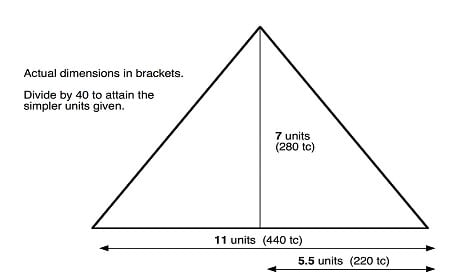
Fig 1.The fundamental dimensions of the Great Pyramid are 7 : 11.
Various writers have previously mentioned this 7 : 11 ratio for the exterior of the pyramid. In fact, it is even in Petrie’s Pyramids and Temples of Gizeh amongst many others. And the 7:11 ratio of the Great Pyramid’s external casing stones has occurred because the pyramid is constructed using the mathematical constant, Pi, as a model or guide. The simplest Pi ratio that maintains whole-number values on both sides of this mathematical constant is 7 : 22, and it was from this ratio that the 7 : 11 ratio for the pyramid’s external dimensions was drawn. The increase from 11 to 22 is due to the formula for a circle being multiplied by 2 (ie: 2 x Pi x r).
However, the complete solution to the small shaft riddle came when it was noticed that the numbers involved in the shaft angles, also embody these very same Pi ratios (both the angular elevation, and the linear dimensions of the shafts). The shafts themselves deviate up and down by a few tenths of a degree, but the average trajectory is quite reliable. If we assume that the architect was only constructing angles to the nearest 0.5°, the angles involved in the four small shafts branching off from the Great Pyramid’s main chambers are 45°, 39.5°, 39.5° and 32.5°.*2
This is supported by the following quote from Graham Hancock’s website: “If the Great Pyramid exhibits the dimensions of the golden ratio, then mathematics automatically implies the pi ratio, so that 0.618… =1/Φ ≈ (π/4)2 = (3.1416/4)2 = 0.617… The Φ (Kepler) theory gives a theoretical angle of 51°49′ 38 (51.827°), while the π theory results in an angle of 51°51′14 (51.854°), very close to each other. The Φ and π theories are in such great contention as the primary design theory because of this close similarity. The dimensions and particularly cubit measures described above could therefore reasonably fuel either viewpoint. It also provides an argument that the Great Pyramid may have been designed to exhibit both ratios. In particular, the π theory is very appealing if one subscribes to the generally accepted idea that the height and base of the Great Pyramid is 280–440 cubits and thus the implied 22/7 ratio (approximation of π). Even the consummate surveyor Petrie subscribed to the π theory since it had corollary appeal in the British scientific milieu of the late 19th century. This ratio is also particularly interesting to those who would relate the design of the pyramid to
the circumference of the earth and embody it with other cosmological ideas.”
And if we plot those angles and lengths on a cross section of the pyramid, something interesting happens -the rise in each shaft is exactly 70 Royal or Thoth cubits (tc). And 70 tc is exactly 1/4 the 280 tc of the Pyramid’s vertical height itself. So the linear dimensions of the small shafts, including their all-important vertical rise in cubit lengths, are mathematical and related to the cubit dimensions of the Pyramid itself.
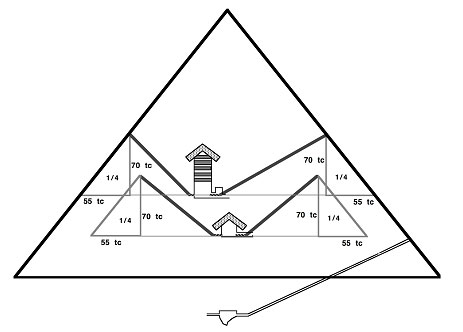
Fig 3. The vertical rise of the small shafts is 70 tc in each case, or 1/4 the 280 tc vertical height of the Great Pyramid.
And while this is all quite clever, there is more to this shaft symmetry, much more. If we subtract the larger angle from the smaller angle on each side of the pyramid (the north and south sides), the numerical differences between the angles are as follows:
45° minus 39.5° = 5.5°
39.5° minus 32.5° = 7°
The value of 5.5 is obviously 1/4 of 22.
Surprisingly, here are those same Pi ratio numbers yet again (7 : 11 or 7 : 22), but here they are involving angles, not lengths. Again, the complex nature of these shaft angles can be seen. They not only produce linear dimensions that relate to the dimensions of the pyramid, but the numerical differences between their angles is also intimately related to the dimensions of the pyramid. This is a surprisingly complex thing to achieve, especially as the starting point for all these numbers is fixed by the mathematical constant, Pi! This is achieved in part because the pivotal angle of 39.5° can be derived from (2 x Pi) 2, and also from the arc-sine of 7/11 (or 1/2 Pi).
And the really important outcome of all this surprising mathematical symmetry, is that it shows how the Great Pyramid reflects a projection not only of the North Hemisphere of planet Earth, but also projects a reflection of the Northern Sky over the ecliptic, as seen in the pole star alpha Draco–Thuban as it transitioned to the current pole star of Kochab, Al-Ruccaba of Ursa Minor. Readers can see that the lengths and angles of the shafts in the Great Pyramid rely on a constant of mathematical Pi as a fundamental of their design criteria. They are Pi-based shafts. But this means that their angles of elevation are fixed by Pi, and not by the position of a particular star in a certain Age of Precession. A Pi shaft angle thus points at a fixed angle, but most stars pointed out by star shafts of the Great Pyramid are variable-related to precession of the equinoxes.” #25
Depending on the Age of Precession, the star shafts of the Great Pyramid can be aligned to different stars, based on changing angle of elevation of the star via precession. This is an example of how the star-shaft theory can fit. If we discovered a shaft angle of 55°, this would equate to the position of Orion in about 4450 BC. And for any angle related to an Age of Precession, we can find the star shafts of the Great Pyramid aligned to certain stars whose star name, given by God [Ps. 147:4, Isa. 40:21-26] holds a Bible message that complies with the foreordained dictates of precession. This is not a “random or infinitely flexible” system, but variable according to the movement of for example, the pole star alpha Draco–Thuban as it transitioned to the current pole star of Kochab Al-Ruccaba of Ursa Minor, via the precession of the poles, over the last 5000 years. This embodies the shift of spiritual power from the dragon at the North pole to Cepheus the enthroned human king, [Christ @ God’s right Hand] with the North Star Polaris under his feet [Eph. 1:19-22] in this precession of spiritual power, pictured below.
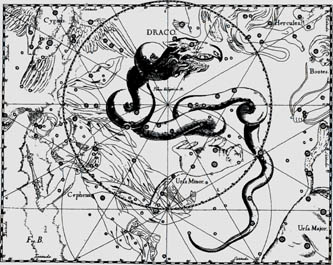
As the Great Pyramid star shafts thus incorporate a map of sorts of the stars of the heavens, if we take note and pay attention to the star names pointed out by the star shafts of the Great Pyramid, they relate a narrative linked to passages built-in to the Great Pyramid. In a recent example below the apex & shafts of the Pyramid aligned with certain stars and planets significant for their links to Christ during key Hebrew Holy Days in Sept. 20, 2017. It must be realized the since the angles of the star shafts of the Great Pyramid are built-into the Great Pyramid superstructure at Pi ratio angles, the static shafts of this monument are set against the movement of the stars in the heavens, based on precession. So when the shafts or passages align with certain stars and/or planets they relate a story of key details relative to Jesus Christ. As seen in the graphic below; we find a culmination of the Jupiter-Venus unions in a Phi relation leading to the Ascending/Descending passage alignments of the Great Pyramid with both Jupiter below the Horizon and Venus aligned with Regulus above the Horizon. This Pyramid passage alignment of Venus and Regulus took place on Rosh Hashanah, Sept. 20-21, 2017 emphasized the Rev. 12 sign alignment of Venus, Regulus, Mercury in Leo, forming the Crown of Virgo in the repeat of the Rev. 12:1-2; “Great Wonder in Heaven” two days later on Sept. 23rd 2017. This crowning of Virgo, reflected the triple coronation of Regulus by Jupiter’s king planet retrograde motion in 3-2 BC, at the birth of Christ, as it also sets up a potential sign of the return of Christ, when these signs will be seen again in 2028.
Since the fixed star shafts of the Great Pyramid, will not always point at the same stars in motion all the time, when they do align with certain stars, it will be only at key times that the Pyramid was built to recognize. If we recall that these key markers will have both geographical and astronomical relevance, then it will be possible to interpret the message of the stars the shafts are aligned to, in light of the applicable Covenant of God and their related geography.
These star shafts were clearly important, as their complex design must have doubled the construction-time for the Pyramid, as Rudolf Gantenbrink has shown with his detailed engineering designs for the Pyramid. Gantenbrink has supplied what I would refer to as a plausible explanation of the geographical application [See http://www.cheops.org] of the Pyramid’s shadow arms seen in the proposed observations of Lemesurier. #26 In his professional diagrams and detailed explanations for these small shafts. As he explains;
The Pi ratio of 7 : 11 is all about lengths, not angles. The angular differences we have used, of 7° and 5.5°, are angular measurements and therefore have nothing to do with the linear measurements that are fundamental to the Pi ratio. So the architect has devised a riddle for us to solve – ‘When is an angle not an angle but a length?’ This may sound like an impossible question to resolve, but the answer lies on every map. To plot a position on a map we need a latitude and longitude. But when using this plotting technique, it is convenient to have a distance measurement system that is related to the dimensions of the Earth itself. Thus the unit used in nautical navigation is the Nautical mile, which is defined as being 1/21,600th of the circumference of the Earth, or 1/60th of a degree of latitude. As an aside, the length of the Nautical mile is thus twice the Great Pyramid’s circumference, marking another key earth measure locked into the Great Pyramid.
Isa. 19:19 refers to the entire land of Egypt with specific regard to its Biblically recognized borders, and thus coincides with the “pillar at the border thereof to the Lord,” referred to in this verse. What is interesting about these borders is the only means available to ancient astronomers of obtaining accurate latitude and longitude coordinates was by way of astronomical sightings. Professor Stecchini {holds a Harvard Doctorate in classical measurement} conclusively shows that early astronomers from the third millennium B.C. could measure latitude to within a few hundred feet and do almost as well with longitude-a feat which was not repeated until the eighteenth century of our era… the ancients knew the length of the earth circumference very precisely, the length of their country almost to the cubit, and the geographical coordinates of all the main points in their realm from the equator to the Mediterranean…the sophistication of the ancients is demonstrated by the fact that they placed their observatory near Syene on the island of Elephantine, 15’- or half the diameter of the sun–north of the actual tropic because they understood that it was not the center of the sun, but its outer rim which has to be observed…On the island of Elephantine was the famed well, whose bottom was said to be completely illumined once a year when the sun stood directly overhead at the solstice…By establishing the moment of solstice at the tropic {of Cancer} the ancient astronomers ably computed the correct circumference of the earth by the use of deep wells and obelisks. #27
This correlates to Ellis’ assertion that the answer to his ancient architect’s geographical conundrum lies in the definition of the Nautical mile, for this unit is related to the size of the Earth and it can therefore be measured as an angular measurement, focused on the center of the Earth. One degree of arc at the center of the Earth=60 Nautical miles of latitude on the surface of the Earth; and so we have found a very neat and logical occasion when a linear length is defined in terms of angular measure. It occurs each time a navigator plots a position on a map. So, the Pyramid’s shaft angles are geo-coordinates on a map of our planet.
What every grand quest needs is an ancient map, with ‘X’ marks the spot inscribed upon it. Strange as it may seem, it appears that we have exactly that within the Great Pyramid. As is explained in K2, Quest of the Gods, the outline of the Great Pyramid’s chambers represents a perfect outline of the continents of the Earth. But of what use is a map of the world, without some coordinates to place upon it? An interesting map requires an ‘X’ marks the spot marked on it. Well, we now appear to have just that – a set of coordinates to place upon our Great Pyramid map!
Understanding this clever conundrum allows us to plot the Great Pyramid treasure-map, at long last. We have four shaft angles that can be used for this exercise, and therefore four coordinates that can be plotted on a map. These angles are:
King’s Chamber 45° & 32.5°
Queen’s Chamber 39.5° & 39.5°
And in doing so, something quite remarkable happens. Because the differences between these shaft angles were exactly 7 and 5.5 degrees, as was explained previously, the two points on the world-map are in very specific locations relative to one another. And if the points are joined up, as has been done in the following diagram, the triangle so formed measures precisely 7 x 5.5 degrees of latitude and longitude respectively. If the triangle is doubled with its obvious symmetric partner, then the resulting triangle drawn on the surface of the Earth becomes 7 x 11 degrees in size – exactly the same dimension ratio that was employed in the Great Pyramid itself.
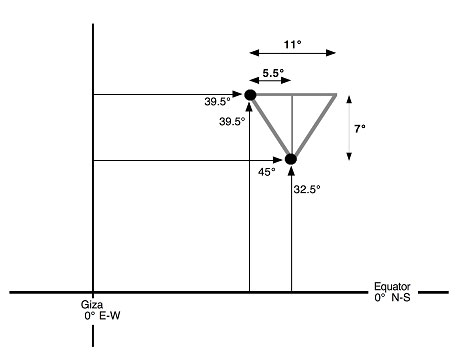
Fig 4. Plotting the Great Pyramid’s shaft angles on a map, gives a triangle with the same ratios as the Great Pyramid itself.
Here, drawn on the surface of the Earth, is an immense triangle that has exactly the same ratio of dimensions as the Great Pyramid, and this has been drawn using the angles given to us by the shafts inside the Great Pyramid itself. Is this a coincidence? Rudy Gantenbrink thinks not…
This concept presented by Gantenbrink depicts a systematic theory of the symmetrical structure and use of the Star Shafts of the Great Pyramid, that is worthy of the Godly design and purpose of the Great Pyramid, in line with the wisdom of the Almighty, and His astronomical and geographical message tied to the Tabernacle and Temple of Israel. It is fitting that the Pyramid’s star shafts are aligned at Pi based angles, and we are proud to recognize them on Pi Day 2024!
God Bless!
Rene’

